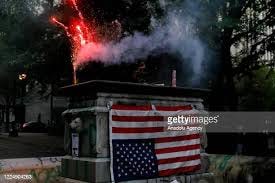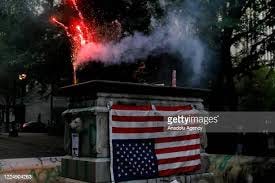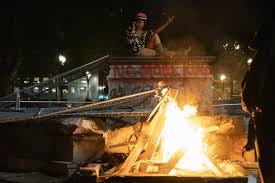I wrote the following in the wake of July 4th, 2020. “Because I don’t know what I think until I read what I say,” in the words of one imperfect woman.
Some of the sentiments have changed, some haven’t. But here’s a snapshot of honest thought, from 2021, in remembrance of 2020.
I plead you judge not—history judges all.
October 7, 2021
The dark night of my worldview came during the summer of 2020, a truly insipid season in American history. It was then, and to an extent remains, the plague or something like it. Most days, before May 2020, the contagion was invisible, except for our mandated reaction to it: school and business closures, masks, the new distance between us.
On one of the stranger days, springtime in Portland, it looked like a scene from a nineteenth-century cholera novel, or the end of Death in Venice. People outdoors were inexplicably supine in the streets and parks of my city, gasping at the sky in new and unrecognizable ways, unable to respire.
Unable myself to discern whether this ubiquitous prostration was from exhaustion, depression, or viral infection. Whether these individuals were collapsed under something beyond the debilitating fatigue of homelessness, narcotic stupor, or simple repose beneath the skies of spring.
Strange had sprung. Breonna Taylor fell victim to a blunderous police raid, and George Floyd was murdered over Memorial Day weekend.
By July, the Prez was sending Federal Agents in unmarked vans to scoop people off the streets of my adoptive hometown of the past twelve years, in what surely looked like an Executive provocation.
Over Fourth of July weekend, he requested an Air Force One fly-by of Mt. Rushmore, to the strains of “Sweet Child o’ Mine;” demanded and received a fireworks display over the Black Hills of South Dakota during peak fire season; superimposed his mug next to the Great Emancipator during a photo-op of the monument; then staged a similar campaign booster from the South Lawn of the White House the following afternoon, on Independence Day.
Those same hours, protesters began heaving spectacle artillery—launching firework mortars—into the entrance of the Federal Building in downtown Portland (“The Justice Center”), which would endure continuous protests, and performative violence, for a century of days to come.
Now I know what to the dog is the Fourth-of-July, how my cat feels about fireworks.
As the sun set, a colossal blood-red moon began to peer over the horizon like the bleary eye of some half-gone Titan leering over the earth, blinking for one long moment, slowly lidded behind clouds of smoke. Only to reassert its foul gaze anew, from a greater height—like the shirtless, mosquito-bitten, unevenly-sunburned, sans-underpants inebriate I watched peel himself off the floor of a local supermarket, hours earlier. Or like the bloodshot orbs of the Naked Emperor himself. As the eye of the moon came-to, the explosions began.
If you want to experience a bad trip, but are hesitant to subject your already fragile American psyche to psychedelic drugs, I suggest you begin by watching ABC’s broadcast of Trumps’s 2020 “Salute to America” celebration on a portable device, insert the headphones into your brain like some infectious tropical worm, switch to audio, put your phone in your pocket, and go for a walk in the park alone on the Fourth of July, as you listen to the President’s self-contradictory vision of American Carnage and Success.
Then tune-out the noise and listen to the Revolution in person.
As I left my house for an addled, early-evening, Independence Day stroll in the park, I began clocking the normal, resting pulse of amateur firework celebrations. As they rose without climax, in an endless crescendo of feverous percussion, emanating a chorus of shockwaves more suited to a Naval proving ground or carpet-bombing campaign.
Without talking to anyone, or heeding the news, just by stepping outside in Portland of an evening, I could take the pulse of the nation. During election year and contagion, on her birthday.
She was convulsing. From one moon to the next…
In August, absurd flotillas of Trumpists gathered for boat parades, in such frenzied critical-mass that several vessels literally sank themselves beneath waves of their own making, in perhaps the most apt metaphor of the season.
The tranquil lagoons of Lake Travis, cupped in the hills surrounding Austin, Tx, were likewise churned into an angry sea.
According to the news.
Boats were involuntarily scuttled on the metro waterfront of downtown Portland. A morbidly obese man appeared to abandon his sinking family on the Willamette River, their ski boat swamped, his blood-relatives shrieking vainly for salvation from fellow mariners. Nautili passing by, after their captain jumped ship. Passengers on a tiny Titanic, doomed and squealing like stuffed rats too engorged to swim away from a foundering ship.
If this sounds dehumanizing, it was. We were all rats on a sinking Ship of State that season in hell.
An “antifascist,” taking a break from “giving my daughter an education in the real world,” as he put it, by protesting, ostensibly, the murder of George Floyd, or perhaps Trump’s federal intervention in Portland policing—murdered a Patriot Prayer member outside a parking garage.
A structure I used to frequent during the holiday shopping season, when commerce in-the-flesh was still possible downtown. (In a season, the old ways become anachronism.)
Days after the homicide downtown, the suspect was executed by police in a suburb outside Olympia, who were supposedly serving a federal warrant. With suspicious timing and context that lent the incident a conspiratorial whiff of extrajudicial retaliation, given the recent political agitation, the permeable border between Trumpworld, Proud Boys and law enforcement, the cop-baiting and naively-marketed campaigns to “Defund the Police” which preceded the homicide, and the deadly apprehension of the left-wing perpetrator that followed his killing of a right-wing agitator.
For years, I’ve driven myself to exasperation reassuring family members, back home in Texas, that the images of Portland in the national media were outlandish Portlandia caricatures at best. Yet, when a noodle-headed mayoral candidate, a frontrunner, was photographed at a campaign event that summer, sporting a printed dress dappled with headshots of Mao and Stalin, I had to concede that life itself was now a caricature of reality. We were all LARPing our way through the last days in a public Theatre of the Absurd.
Disregarding the wildfires to come, even before the forests began to smolder that August, venturing into the countryside to escape the heat felt like an act of faith and hazard, equal to venturing downtown after dark. En route to a rural waterfall and swimming hole across the state line, the roadside was draped in banners extolling the Presidency and, in some places, the Confederacy—six degrees above the Mason Dixon line, in Washington state.
People were cowed, or at each other’s throats. Conversation around the swimming-hole oasis was anxious and fraught, even among familiars, in-groups from town and country alike. Topical discussion was touchy.
There were internecine homicides. Actual Fear and Loathing. The Kentucky Derby wasn’t decadent that year, but it was depraved—and delayed. Postponed by the pandemic, the race was rain-checked until September, when national media portrayed armed confrontations tumescing between black and white militias outside of Churchill Downs.
By the postponed Derby in September, we had already whipped the horse’s eyes and were off to the races—chaos. Wildfire consumed the West, deluge the East. A rumorous noise was on the land, an affect of the flood and flame.
In the middle of one inferno, a forest fire in Oregon, some crazed pyromaniac run amok, like a hallucination trespassing the highways of reality, was reportedly seen igniting brush fires along the I-205 corridor south of Portland.
There were already multiple fires encroaching on the city, normally insulated from the rural fire season. When it came to media, culpability, and gullibility, the consensus was in nothing, yet one same thing. The highway arsonist was the Other Side. Antifa, Proud Boy; Stalin, Hitler; Xi, Putin; Santa Clause, the Easter Bunny; false flag, patriot flag; it didn’t matter.
It was Them whut did it.
In several small towns along coastal northern California and southern Oregon, armed vigilantes were said to be stalking Main Street, waiting for supposed BLM protesters and Antifa anarchists, bus-loads of leftist conspirators who never materialized, Marxist specters dispatched from the chatrooms of the national psyche to invade small town America. The single-digit “BLM” representation that did show up to counter-counterprotest these reactionary posses in the coastal hamlet nearest me, appeared to be a handful of small-town teenage outcasts, freckled neighbors from down the street in a sleepy seaside village.
A family of humans—recently abstracted and de-individualized as capital-B “Black,” “BIPOC,” and other newly-minted, dehumanizing epochal euphemisms and acronyms—a group of fellow Americans, with more melanin than some of the capital-W “White”rural locals, vacationing in their family wagon, was shamefully detained at a makeshift roadblock constructed of chainsaw-felled trees, interrogated by paranoid pale country folk, who suspected their fellow citizens of being leftist agitators from the City come to invade their Town.
The Portland Police Bureau’s union offices were set ablaze. The North Precinct burned while people cowered inside, and the East Precinct nearly met the same fate. The pedestal where a downtown landmark once stood, a bronze statue of an elk (the “racist” “colonizer” animal—not the Elks fraternal order) smoldered, its denigrated ashes now strewn with reverential flowers, for some impenetrable reason.
Across the street, City Hall was converted into a plywood citadel, along with the Federal Courthouse, and the storefronts of countless businesses across town.
Before they became opportune canvases for graffiti and memic sloganeering, the plywood barriers were billed with BLM posters and professional murals, painted-up by the businesses themselves like paschal lamb’s blood.
The signage and murals became an adornment of the protective barrier, rendering the distinction between political support and commercial self-preservation nebulous. As righteous Portlanders, it’s likely many, if not most, of these proprietors espoused genuine support for the movement, but they were undeniably cognizant, subconsciously or pragmatically, of the fact that a visual endorsement of the Resistance was tantamount to blood over the threshold, screaming “Passover,” ye teenage vandals here.
That subtext, the discomfiting tension between fear and political endorsement, was impossible to ignore, being writ large on the surface of every privately-owned building with vulnerable storefront windows. Most of the vandals were undoubtedly White Riot humpers and teenage chatroom hacktivists, moonlighting as Banksy revolutionaries and indignata performance artists.
Some of these pale protestors destroyed black-owned businesses in the historically-black neighborhood of Kenton.
A monument in the park near my home, memorializing some obscure, local nineteenth-century newspaper entrepreneur, was toppled. The plinth and plaque scribbled with “colonizer” and “land back” sentiments, which were bleached by day, reapplied by night, whitewashed and ritually re-graffitied night after day.
Until weeks later, the base of the missing statue was surreptitiously adorned with a new bust—a priceless creation amid the bankrupt acts of wanton destruction—with a new plaque, describing the history of an Afro-American frontiersman.
Who was then decapitated, re-headed, and beheaded, nightly, like some cautionary metropolitan Prometheus tale.
Finally, the barren pedestal found its true purpose. As a vacant platform for photogenic park-goers, to mount and pose upon for selfies. An ever-evolving monument to colonization, racism, anti-racism, empty iconoclasm, revolution, and narcissistic self-aggrandizement.
The pedestal remains unadorned, a topless stele tombstone: Here lies America, July 4, 2020.
A year later, these memories can hardly be summoned, or captured. They march at will, thronged on both sides by protective barriers of amnesia, in a fleeting parade. Recollections of estival 2020 are like the falling ticker tape of trauma secondhand. Beheld for a moment, flickers of media tinsel and personal experience, before disappearing into the gutter of the mind. It’s difficult to place them exactly in time, but it all happened, or began, or culminated, in the dumpster-fire summer of 2020.
There’s no judgement in that descriptor; dumpsters were set aflame.
It was The Fire Next Time, and it was on the world. Confined at home that winter by quarantine, expelled into the streets that summer by racial angst, confined again under a pillar of smoke and mob rule, with wildfire lapping around the edges of The City, and within it.
This is what it feels like to sojourn in the nightmare of history. Some of these phantom events may not have actually transpired, for all I still know; perhaps all of them did. But I witnessed many of them firsthand. The rest were reported in legacy or local media. False stories have real consequences, however, and rumor instantiates reality daily. Sometimes the rumors are exactly that, “noise”; sometimes they’re signal.
It’s an uncanny feeling to be alerted to developments rumored from the streets of your hometown, events to which you were clueless amid the mayhem, notified by a friend living on the other side of the earth, in Saigon, Vietnam—and have the reports turn out to be true (Feds scooping up protestors in unmarked vans on the streets of Portland).
It’s even more uncanny to see people mobilized to action by online noise that turns out to be as insubstantial as it sounds, yet basically manifests the same results: madders in the streets (right-wing vigilantes supposedly menacing coastal Oregon towns, racially-indifferent citizens turned social-justice Robespierres overnight, summoned by a black square meme on Instagram). Maybe we all acted like citizens’ militias chasing chatroom phantoms that summer of fire, that Saison en Enfer.
It matters little that I witnessed many of these events with my own eyes, unmediated. Because in the end, this is what it felt like: not being able to trust your own eyes. Blind instinct, divorce from reason. Lizard desire.
“I see all History as a lovesick boy fumbling his sex in the darkness”
The poet once said. Delmore Schwartz, the man who taught lyricism to Lou Reed.
The blind, instinctual groping of history advancing slowly, then suddenly, without quite knowing what it’s doing. An obscene natural process we finally awoke to in the middle of the night, at the messy climax, nearly past the point of no return.
Virginia Woolf said that, on-or-about a certain date, human character changed forever. For her it was December 1910, when relations between “masters and servants, husband and wives, parents and children” were turned upside down—“and when human relations change there is at the same time a change in religion, politics, conduct, and literature.”
For me that date was sometime around last July, the 4th, 2020.
—Meditations, 7 Oct. 2021







